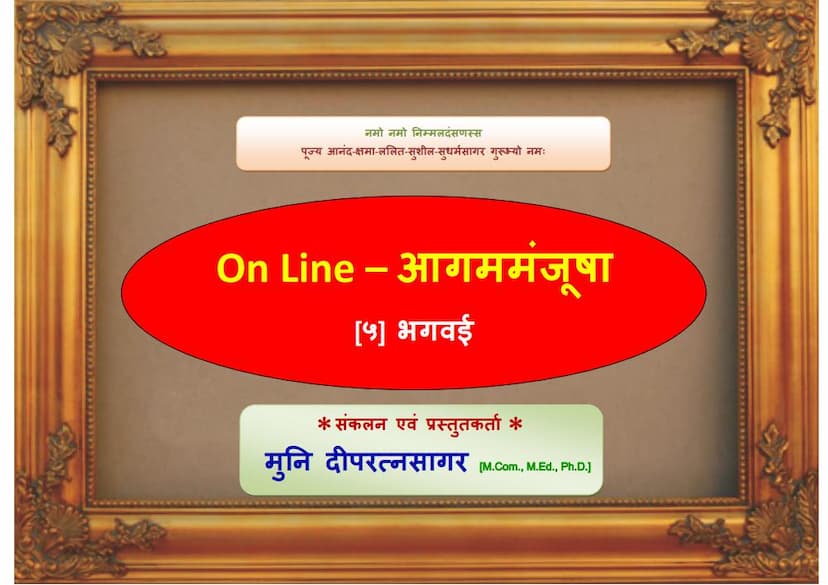Aagam Manjusha 05 Angsuttam Mool 05 Bhagavati
Added to library: September 1, 2025

Summary
The provided text is a detailed philosophical and cosmological discourse within Jainism, specifically the Bhagavati Sutra (also known as Bhagavati or Viyaha Pannatti), which is part of the Agamas. The excerpt you've provided focuses on the descriptions and classifications of various elements within the Jain universe, particularly concerning karmic principles, sensory experiences, and the nature of existence.
Here's a breakdown of the key themes and concepts presented in the text, organized for clarity:
I. Introduction and Context:
- Digital Archiving of Agamas: The text highlights the digitization and online presentation of ancient Jain scriptures like the Bhagavati Sutra, emphasizing its significance for wider accessibility and preservation. It mentions that this online version is a continuation of a project initiated 70 years prior.
- Authorship and Publisher: The work is attributed to Anandsagarsuri and Sagaranandsuri, published by Deepratnasagar, with Munishri Deepratnasagar as the compiler and presenter.
- Dedication: The text begins with a Jain mantra and a salutation to revered Gurus, indicating its devotional and spiritual context.
II. Key Jain Philosophical and Cosmological Concepts:
-
Karma and Its Effects: A significant portion of the text delves into the intricacies of karma. It discusses how different types of souls (jivas) bind, emit, experience, and shed karma. The concepts of chalit (moving) and achalit (non-moving) karma are explored, along with the time periods associated with their manifestation. The text also touches upon the impact of karma on one's lifespan and experiences.
-
The Nature of Existence and Reality:
- Dravya (Substance): The text refers to fundamental substances like dravya (substance), dravya-kshetra (substance-space), dravya-kala (substance-time), dravya-bhava (substance-state), and dravya-guna (substance-attribute).
- Jiva (Soul) and Ajiva (Non-soul): It discusses the relationship and interaction between souls (jivas) and non-soul substances (ajivas), including the role of karma in binding them.
- Space (Agasa) and Time (Adha): The text touches upon the concept of space (agasa) and its vastness, differentiating between mundane space (lokakasha) and supramundane space (alokakasha). It also discusses time (adha) in terms of past, present, and future.
-
Sensory Perception and Consciousness:
- Indriyas (Senses): The text mentions the five senses (sight, sound, smell, taste, touch) and how they interact with the external world. It discusses the purification of senses and the potential for spiritual liberation through them.
- Leshya (Karmic Hues/Auras): The six leshya (kala, neela, kapota, peeta, padma, shukla) are mentioned, highlighting their connection to one's spiritual state and actions. The text explores how different activities and states of being are associated with specific leshya.
-
Rebirth and Transmigration (Samsara):
- Jiva's Journey: The text describes the soul's journey through various realms of existence, including hellish beings (neraiya), celestial beings (deva), and inferiors (tiraykya yonija). It details the characteristics of these beings, their lifespans, and the karmic causes that lead them to these states.
- Karma and Rebirth: The interconnectedness of karma, actions, and the cycle of rebirth is a recurring theme.
-
Liberation (Moksha): While not explicitly detailed in this excerpt, the underlying goal of Jain practice is liberation from the cycle of rebirth. The discussion of purifying senses, reducing karmic bondage, and understanding the true nature of reality points towards this ultimate aim.
-
The Universe (Loka): The text implicitly refers to the Jain cosmology, with its various realms, celestial beings, and the concept of the universe being pervaded by space (agasa).
III. Specific Concepts Discussed:
- Types of Beings: The text categorizes beings based on their senses (from one-sensed to five-sensed), their existential states (hellish, celestial, human, animal), and their karmic dispositions (leshya).
- Causality and Action (Karma): It emphasizes the principle of karma, where actions (kriya) have consequences, and the impact of intentions (yog) on karmic outcomes. The distinction between actions that lead to bondage and those that lead to liberation is crucial.
- Subtle and Gross Existence: The text hints at the concept of subtle (sukshma) and gross (sthula) forms of existence, particularly in relation to the soul's interaction with karma and the physical body.
- Time and Space: The vastness of time and space within the Jain cosmology is alluded to, with discussions on lifespan (ayu) and the cyclical nature of existence.
- Discipline and Practice: The importance of practices like self-control (sanyam), penance (tapa), adherence to vows (mahavrata), and ethical conduct is evident throughout the text. The example of the monk Khandaka and the layman Udayana and his wife Mahapratibha (or Devananda as per another mention) highlights the path of spiritual discipline.
- Knowledge and Perception: The text distinguishes between different types of knowledge (jnana) and perception (darshana), including worldly knowledge (matijnana), scriptural knowledge (shruta-jnana), and clairvoyant knowledge (avadhi-jnana), with kevala-jnana (omniscience) being the ultimate goal. It also discusses ignorance (ajñana) and its various forms.
- The Jain Path: The emphasis on right faith (samyak-darshana), right knowledge (samyak-jnana), and right conduct (samyak-charitra) as the means to liberation is a central theme.
IV. Structural Elements:
- Question-Answer Format: The text largely follows a question-and-answer format, typical of Indian philosophical dialogues, where the disciple (goyamaswami, malindiya, vuyama, etc.) asks questions to the Tirthankara (Mahavir Swami) or his chief disciples, who then provide detailed explanations.
- Categorization and Classification: Jain scriptures are known for their meticulous classification of reality into various categories. This text exemplifies that, categorizing beings, actions, karmas, and even sensory perceptions.
In essence, this excerpt from the Bhagavati Sutra provides a glimpse into the comprehensive nature of Jain philosophy, covering cosmology, ethics, the theory of karma, and the path to spiritual liberation. It illustrates how Jainism analyzes existence through detailed categorization and causal reasoning, aiming to guide individuals towards righteous living and ultimate freedom from suffering.